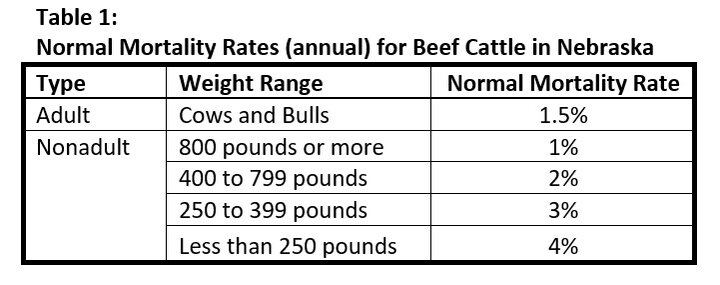This article is a summary of the December 10, 2020 Cornhusker Economics article titled: “The Livestock Indemnity Program: A Case for Managing Risk with Good Recordkeeping.”
The Livestock Indemnity Program (LIP), one of the USDA disaster assistance programs administered by Farm Service Agency (FSA), provides compensation to eligible livestock producers who have suffered livestock death losses in excess of normal mortality due to adverse weather, such as blizzards, floods, extreme heat, extreme cold, wildfires, tornados, and lightning. LIP also covers attacks by animals reintroduced into the wild by the federal government or protected by federal law, including wolves and avian predators. Eligible livestock includes beef cattle, dairy cattle, bison, poultry, sheep, swine, horses, and other livestock as determined by the U.S. Secretary of Agriculture.
LIP provides compensation to eligible livestock producers who suffer livestock death losses in excess of normal mortality due to an eligible event. Normal mortality rates are established by FSA on a State-by-State basis using recommendations from State livestock and Extension Service organizations. In 2020, these rates were adjusted in the state of Nebraska for nonadult cattle weighing less than 400 pounds.
Table 1 displays the normal mortality rates for cattle in Nebraska taking effect in 2020. Previously, all nonadult cattle weighing less than 400 pounds had a normal annual mortality rate of 5 percent. For 2020 and later, LIP now includes a weight range from 250 to 399 pounds with a normal annual mortality rate of 3 percent and a weight range less than 250 pounds with a normal annual mortality rate of 4 percent.

Good livestock inventory records can lead to good LIP documentation and provide access to LIP benefits. Producers need accurate counts of the number and type of livestock in their inventory before the eligible loss event. Beginning year inventories are needed as a starting point but they should be supplemented with production records (births, death losses, weaning numbers, etc.), purchase records, sale records, veterinarian records, inventory related bank loan documentation, records assembled for tax filing, and other verifiable and reliable documents that can help determine livestock inventories at different points throughout the year.
Producers must file a notice of loss with their local FSA within 30 calendar days of when the death losses occurred due to an eligible event. The producer can then file an application for payment to request compensation for losses in excess of the normal mortality rate based on inventory counts immediately before the event occurred and the death loss resulting from the event. Multiple notices of losses and multiple applications for payment may be filed by producers that suffer multiple livestock losses during the same calendar year. All applications must be completed no later than 60 calendar days after the end of the calendar year in which the loss occurred (i.e. March 1, 2021 for losses occurring in 2020).
There are two types of death loss to be concerned about, those that are attributed to an LIP eligible adverse event and those that are consider normal death loss. Documentation should always include the type of livestock and the date the livestock died so their death can possibly be attributed to the eligible event. Livestock dying within 30 days of a qualifying event may be considered for eligible loss benefits. Furthermore, date of birth and date of purchase records are extremely important to verify when animals became a part of your inventory and that they were present at the time the eligible event occurred.
Accurate documentation of other death losses are equally important so they can be counted as part of normal mortality for the year. In some instances, it pays to file an application for payment at the end of the year to account for normal mortalities that occurred during the year. A detailed example is provided in the full Cornhusker Economics article which can be downloaded at the following URL: https://agecon.unl.edu/The-Livestock-Indemnity-Program-A-Case-for-Managing-Risk-with-Good-Recordkeeping-2020.pdf.
Good inventory records can be a tremendously effective tool for managing risk in cattle operations. The true impact of adverse weather events is only possible to know if you have good information to base your calculations on. LIP is a program where these good record keeping practices can pay off.
Interviews with the authors of BeefWatch newsletter articles become available throughout the month of publication and are accessible at https://go.unl.edu/podcast.
Topics covered:
Marketing & risk management, Marketing, budgets & management

